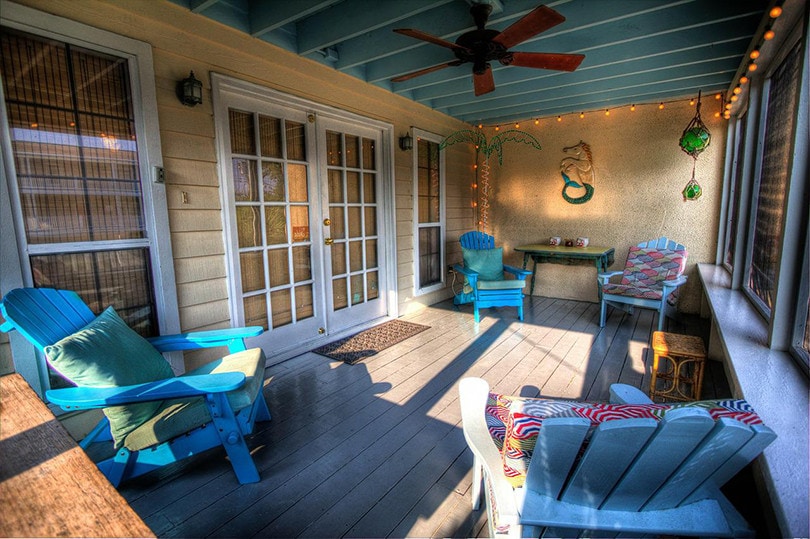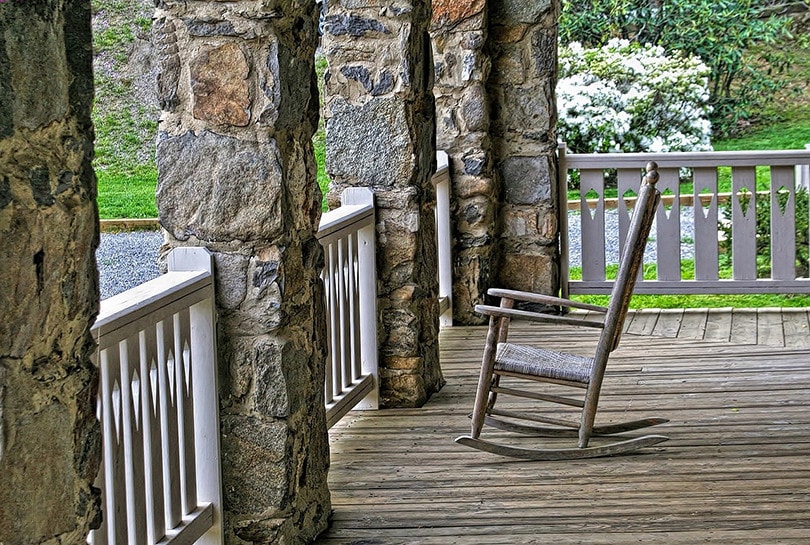How to Stop Birds From Nesting on Your Porch (10 Proven Methods)
Last Updated on

The porch is a precious space in many of our homes. Still outside but tucked away from the elements, it is peaceful to sit in nature.
As much as we enjoy this space, birds do too. The protection of the porch offers up all sorts of nooks and crannies for birds to tuck away to make their nests. Warm, dry, and free from predators, it’s no wonder they like our porches.
However, their presence isn’t always welcome here. Their nests close to the home create noise, mess, and pose a health risk. Keeping them away from the porch but still nearby to watch is a balancing act, so use our ten tips to help you out.

Risk of Wild Birds Close to The Home
We, avid bird watchers, adore having wild birds around our home. Looking out the window to see nature in such a beautiful form is serene, but there’s a risk with birds coming too close to your home and beginning to nest.
Zoonotic diseases can transfer from infected or carrier birds onto our families and us. Examples include:
- Parrot fever
- Histoplasmosis
- Cryptosporidium
- Salmonella
Wild birds can also bring in a range of parasitic organisms, most notably bird mites. If these parasites venture off their avian hosts, they can infect home and bite us, despite not being able to sustain themselves on human blood.
While theoretically you might be okay sharing your porch space with a nest of birds, it’s best to prevent this and encourage them to nest nearby.

Top 10 Ways To Prevent Birds From Nesting on Your Porch
1. Keep Your Porch Clean
The nook of a porch often collects stray organic matter. The wind sweeps twigs and leaves to settle in a sheltered patio. This array of vegetation can attract nearby birds searching for nesting material.
They may then take these items and build a nest close by on the porch. Additionally, unclean areas will attract bugs for birds to snack on; thus, the porch will provide all birds need to thrive.
To make the space less appealing to birds, keep the porch clean by sweeping and hosing it regularly. This is especially important after storms when debris builds up.

2. Noise Deterrent
Birds utilize their sense of sound for their survival. They listen out for the sound of approaching predators such as large mammals or birds of prey. They soon learn which sounds to fear and which to brush off.
A sound-emitting bird scarer can frighten nearby birds and encourage them to move away from the area. Be wary that this may have a broader effect than intended and make your yard an undesirable place for birds entirely.
Other options include noisy wind chimes placed under the porch. Their loud noises and shiny effects can deter birds from this space.
3. Chemical Repellents
There is a range of commercial anti-bird sprays and gels you can apply to areas around the home. These made the space uncomfortable for birds, nudging them to move away from the area.
This technique is suitable for porch spaces as it stays localized.
For a more natural approach, you can utilize citrus scents. Lemon juice and water in a spray bottle applied to your porch deters birds who dislike citrus. As a bonus, your porch will smell like a delicious orchard.

4. Shiny Objects
Use nature to your advantage by reflecting the sun on a fine day to ward off nesting birds. Shiny items refract longs of light rays which can scare and confuse birds, keeping them well away from your porch.
Bird scare rods are available in many garden centers, their twisted silver design a common sight in gardens across the globe. You can use reflective tape for a homemade approach or hang old CDs.
5. Station Your Pets
Birds are naturally scared of larger animals, and rightfully so. In the wild, litter birds are preyed upon by virtually anything bigger than them. Mammals, large birds, and humans are all frightfully imposing.
Obviously, you can’t sit on your porch all day and scare each bird off (even if you really wanted to), but you may be able to enlist your pets in that role.
Making your porch space nice and cozy for your pet dog or elderly cat can entice them to spend time here, keeping birds at bay just with their presence.
While your sweet Labrador may not be that scary, a tiny bird will beg to differ. However, if your cat is an avid hunter, it’s recommended to keep them indoors to spare native animal populations.

6. Make It Physically Difficult
Figure out where birds are drawn to your porch. Often these spaces are wall cavities or under eaves. Once you have identified the place they want to nest, you can use a physical barrier to keep them out.
For example, seal exposed holes. Wires and spikes can be placed in popular spaces, or flashings can cover ledges.
Get creative with how you block off nesting areas. Birds simply cannot settle there if they cannot perch or build a nest.
7. Keep the Bird Feeder Far From the Porch
Birds like to nest in areas near food sources. For them, it’s like having the kitchen accessible down the hall instead of having to nip to the corner store for every meal.
Bird feeders in the garden are a great way to increase the local wildlife in the area, but they may also encourage birds to nest in your porch area if it’s too close.
Position the feeder a significant distance away from the porch, so they aren’t tempted to nest there. This might seem counterproductive, as many like to sit and bird watch on their porch, so consider investing in a nice pair of binoculars or building a seating area closer to the feeder.

8. Plant Native Shrubs and Trees
While your porch space certainly makes a cozy nest site, it’s not a natural place to nest for any birds. Most birds build nests in trees or shrubs or nest in natural cavities. They may be more drawn to your perch if there are not naturally enough nesting sites.
Plant up your property with native trees and shrubs to build a habitat for your neighborhood birds. Creating these habits can benefit the ecosystem as a whole, attracting more bugs and bees to your garden.
9. Install Nesting Boxes
Many properties are limited with space for gardens. There may be many more birds in your area than there is natural foliage to house them, causing them to nest in artificial spaces like your porch.
To boost the nesting real estate, install some basic nesting boxes. Various species love to use wooden boxes, especially cavity nesters. You can keep birds away from your home while still ensuring they are safe and warm.

10. Use a Decoy
While a plastic bird may not be your choice of porch decor, the presence of an imposing sight such as an owl or a falcon can be enough to spook birds away from your home.
However, even the tiniest of birds are clever, and many will become accustomed to the decoy and begin to ignore it over time, so decoy use should be sporadic.
Conclusion
We hope our tips and methods today help you keep birds away from your tranquil porch space. Many of these methods may not work independently, so a combination of suitable approaches might work best for you.
It’s important to keep the bird’s safety as your top priority. If you simply cannot remove the birds or keep them at bay, consider contacting a professional from animal or pest control to assess your situation.
- Related Read: How To Get Rid Of Birds In Attic (8 Proven Methods)
Featured Image Credit: PublicDomainArchive, Pixabay
About the Author Sophie Herlihy
After an early start in the veterinary industry and as a conservation educator at Disney’s Animal Kingdom in Florida, Sophie has since been a successful Zookeeper and Conservationist, specializing in native New Zealand species. When she isn't bird watching in native forests, she can be found with her husband on their sheep and beef station, far from civilization. Sophie enjoys her writing career as it provides opportunities to help and support pet owners of all kinds and getting to research and write about a broad range of topics. The only downside is the long list of strange searches in her internet history!
Related Articles:
10 Types of Hummingbirds in Arkansas (With Pictures)
8 Types of Hummingbirds in Nebraska (With Pictures)
5 Types of Hummingbirds in Idaho (With Pictures)
3 Types of Hummingbirds in Mississippi (With Pictures)
8 Types of Hummingbirds in Kansas (With Pictures)
5 Types of Hummingbirds in West Virginia (With Pictures)
5 Types of Hummingbirds in Ohio (With Pictures)
Where Do Nuthatches Nest? Nuthatch Nesting Habits Explained
